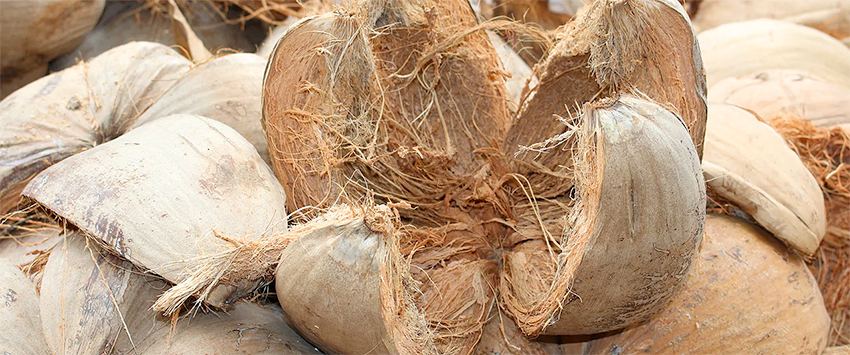
Coco Coir and Soil Blends
Coconut coir, also known as coco coir or coco peat, is derived from the fibrous husk surrounding the coconut. It is widely used as a growing medium in potting soil and hydroponic systems due to its excellent water retention and drainage properties. Here’s a breakdown of how coconut coir is sourced and utilized in potting soil:
Sourcing Coconut Coir:
- Harvesting: Coconuts are harvested from coconut palm trees when they are fully ripe.
- Husk Removal: The outer husk of the coconut, which consists of coir fibers, is separated from the inner nut.
- Retting: The husks are soaked in water or left in outdoor environments for several months to decompose and soften the fibers.
- Fiber Extraction: After retting, the coir fibers are mechanically separated from the decomposed husk.
- Washing and Drying: The extracted fibers are washed to remove impurities and then dried in the sun or using mechanical drying methods.
- Grading: The coir fibers are graded based on their length, texture, and quality.
Utilizing Coconut Coir in Potting Soil:
- Mixing with other components: Coconut coir is often blended with other ingredients to create potting soil mixes. Common additives include perlite, vermiculite, compost, or sand, depending on the specific requirements of the plants.
- Water retention and drainage: Coconut coir has excellent water-holding capacity, allowing it to retain moisture while still providing adequate drainage. It helps prevent the soil from becoming too compacted or waterlogged.
- Nutrient absorption and release: Although coconut coir itself is relatively low in nutrients, it has cation exchange properties that allow it to absorb and release essential plant nutrients. This helps provide a favorable environment for root growth and nutrient uptake.
- pH balance: Coconut coir has a near-neutral pH, which makes it suitable for a wide range of plants. It helps maintain the pH balance of the potting soil, promoting optimal nutrient availability to plants.
- Environmental sustainability: Coconut coir is considered an eco-friendly alternative to peat moss, which is commonly used in potting soil. Coir is a renewable resource, as coconut palms produce coconuts throughout their lifespan.
Overall, coconut coir is sourced from coconut husks and used in potting soil due to its moisture retention, drainage capabilities, nutrient absorption, pH neutrality, and sustainable nature. Its properties make it an excellent choice for promoting healthy plant growth in container gardening and horticulture.
Coco Coir and Soil Biology
Coconut coir, or coco coir, can have a significant impact on soil biology when used as a component in potting soil or as a soil amendment. Here’s how coco coir can interact with soil biology:
- Microbial Activity: Coco coir provides a favorable habitat for beneficial soil microorganisms, including bacteria, fungi, and other soil-dwelling organisms. These microorganisms help break down organic matter, release nutrients, and contribute to overall soil health.
- Organic Matter Decomposition: As coconut coir is an organic material, it undergoes decomposition over time when added to the soil. This decomposition process is facilitated by soil microorganisms, such as bacteria and fungi, which break down the coir fibers and release nutrients into the soil. The decomposition of coco coir adds organic matter to the soil, improving its structure and fertility.
- Nutrient Cycling: Coco coir can enhance nutrient cycling within the soil. As microorganisms decompose the coir, they release essential nutrients, such as nitrogen, phosphorus, and potassium, making them available for plant uptake. This nutrient cycling process supports healthy plant growth and development.
- Water Retention and Aeration: Coco coir has excellent water retention properties, allowing it to hold moisture while still providing good aeration. This characteristic creates a suitable environment for soil microorganisms. Adequate moisture levels support microbial activity and promote the decomposition of organic matter. Additionally, the improved water-holding capacity helps plants maintain consistent hydration.
- pH Buffering: Coconut coir has a near-neutral pH, which helps buffer the soil against extreme pH fluctuations. This stability is beneficial for soil biology because many soil microorganisms have specific pH ranges in which they thrive. By maintaining a favorable pH range, coco coir supports a diverse and active microbial community.
- Disease Suppression: Coco coir has been shown to have suppressive effects on certain plant pathogens, including fungi and nematodes. It contains natural compounds that can inhibit the growth and activity of harmful organisms, thus contributing to disease management in the soil.
It’s worth noting that the impact of coco coir on soil biology can vary depending on factors such as the quality of the coir, the specific soil conditions, and the presence of other soil amendments or inputs. Nevertheless, when used properly, coconut coir can contribute to a healthy and biologically active soil environment.


